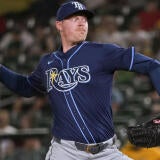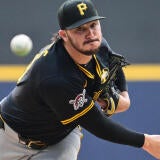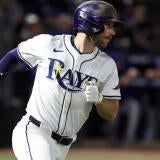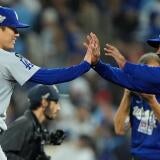Fantasy Baseball Waiver Wire: Blake Snell, Jack Flaherty demonstrate changing expectations; Logan Allen, Adbert Alzolay look like solid pickups
Disastrous outings for talented pitchers have been all too common this season. Scott White explains why the latest aren't of significantly greater concern while also sharing his top waiver wire targets.
Blake Snell and Jack Flaherty were terrible Tuesday. This much no one can deny.
What may be up for debate, though, is what it says about their rest-of-season value.
Snell is the greater concern. Expectations are higher for him, as is the level of investment. Plus, Tuesday's outings make it three disastrous starts in a row, raising his ERA from 3.50 to 5.01.
So what underlying changes have coincided with this three-start stretch? Few that I can see. The most noticeable is that his average fastball velocity is down about 1 mph, which I suppose could be an indicator of injury. But his own commentary would seem to refute that idea:
"I think people would think it's crazy if I told them that I feel better right now than I did last year, and I really do," Snell said. "I'm very confident in the way I feel that I'm going to get the results I want."
It'd be nothing more than wild speculation anyway. Some have theorized that Snell's hurried return from a broken toe heading into May brought about subconscious mechanical changes as a way of compensating for the injury, which would be easy enough to believe if he hadn't dominated for most of that month. His struggles have come more in June.
But whether or not the toe injury was the impetus in this particular case, I would imagine unintentional mechanical changes, most of them barely perceptible, are often to blame for extended rough patches by talented pitchers, of which Snell would certainly still qualify. He's a distant first in terms of missing bats, which is the most valuable skill a pitcher can possess, and while he has had trouble finding the strike zone during this rough stretch, he hasn't gotten hit as hard as you might suspect. Of the 11 hits he surrendered Tuesday, eight were singles, and in the seven total innings he has pitched during this rough stretch, he has allowed all of two home runs.
In an environment where home runs come about all too easily and are directly responsible for some of the crooked ERAs among many of the game's best pitchers, you'd expect a higher number if Snell was truly washed.
Speaking of home runs and crooked ERAs, there's also Flaherty, who served up three of the former Tuesday to raise the latter to 4.75. Not good, but also not terribly unfamiliar.
Flaherty had a 3.77 ERA at the start of June, which is about the point when the home runs became a problem. But his stuff hasn't really changed during that time. He has three eight-strikeout games this month and still boasts one of the best swinging-strike rates in the league. His xFIP coming into the game also pegged him for more like a high-threes ERA than high-fours, all of which is to say I'm not sure he's at fault, really. There's just no accounting for when the league-wide power explosion is going to show up and wreck things.
It's part of the reason why so many exceptionally talented pitchers — from Stephen Strasburg to Patrick Corbin to Shane Bieber to Trevor Bauer to Noah Syndergaard to Zack Wheeler to Carlos Carrasco — have ERAs approaching or exceeding 4.00 even when their skills appear intact. They're having to contend with inflated home run-to-fly ball rates, often the worst of their careers, that end up having sort of a randomizing effect. So the frustration level among Fantasy players is higher — trust me, you're not the only one in your league who feels like your entire pitching staff has betrayed you — but a process-over-results approach is all the more necessary because of it.
The results, after all, could go sideways for any given pitcher over any two- or three-start stretch, and it could have little to do with his actual abilities. Justin Verlander may be the only pitcher who has been entirely worry-free from start to finish, and even his home run-to-fly ball rate is a career-worst.
It's part of the new reality in Fantasy Baseball, with offense being what it is now. All but the most high-end starting pitchers — and even some of them — will regularly have awful starts because there are too many home runs out there to ruin things. Most, then, aren't going to be of much help in ERA and WHIP, in which case you're pursuing them mainly for wins and strikeouts.
The differentiators, then, become how many bats they miss, how deep they're allowed to pitch, how helpful their supporting cast is, and how useful their good starts are. Flaherty still checks enough of those boxes to remain on the must-own side of the ledger.
And as for Snell, his xFIP entering Tuesday's start (3.15) was actually lower than it was a year ago (3.16). If the skills are still intact, the adjustments are possible and I dare say even likely. And besides, in this pitching environment, how are you forfeiting any shot at something exceptional? I've already made it known in my leagues that I'm happy to help out anyone looking to unload Snell and have yet to receive a single offer, which should sum up the industry consensus right there.
His first big-league was start was cut short after he walked the bases loaded in the fifth, but Adbert Alzolay has now allowed all of two hits in 8 1/3 innings. His 12 swinging strikes were divided almost evenly between his fastball, changeup and curveball, which shows he has a deep enough arsenal to start, and the walks are likely an aberration seeing as he had a combined five in his final five minor-league starts.
| |
Another pitcher making his first run at the majors, Logan Allen is now 2 for 2 in delivering quality starts after allowing two earned runs in six innings at the Orioles. He hasn't shown great bat-missing ability, which will be required in the long run, but you'll take a shot on anything resembling upside in this pitching environment. He was a top-100 prospect coming into the year, after all.
| |
If there's one position (other than starting pitcher, of course) where there isn't enough to go around in a standard mixed league, it's catcher, and now that the Padres have seemingly come to terms with the fact Austin Hedges has nothing to offer offensively, one of the position's top sleepers coming into the year has an opportunity to shine. Francisco Mejia has started five of six since returning from the minors, homering for the second time during that stretch Tuesday.
|
While Manny Machado's career numbers away from Camden Yards made a halfway convincing case that his slow start with the Padres may just be the new normal, it seemed like too dismissive of a pronouncement for a 26-year-old heretofore regarded as a hall of fame-level talent. But now he has seven homers in his past 11 games, raising his batting average from .240 to .281, and all is right in the world.
|
Robbie Ray turned in his fifth straight start of at least six innings Tuesday, a mark he reached only twice in his first 12 starts. He'll never be an efficient pitcher, but if he can limit the walks just enough to continue that trend, it'll allow him to take full advantage of his strikeout ability while also improving his win potential.
|
Mitch Garver hadn't been quite the same since returning in early June from a sprained ankle, and then when he missed three consecutive games with a bruised heel, it became imperative for him to perform or risk losing a larger share of the at-bats to Jason Castro and Willians Astudillo. He delivered in his first game back Tuesday, going 3 for 5 with a homer, and remains one of the few sources of hope at a dire position.
|
Even amid speculation over who might replace him as closer, the Braves keep giving those chances to Luke Jackson, and at least on Tuesday, he delivered on it, striking out two in a perfect ninth inning. It hasn't been a good month for the hard-throwing right-hander, but he still has a 3.00 ERA, 12.5 K/9 and the trust of his manager, apparently.
|
You might have been tempted to hold on to Zach Davies for just one more week given the two favorable matchups on the schedule, but so far that move has backfired. He gave up four earned runs in four innings against the Mariners Tuesday and hasn't had a quality start in four starts. The 5.05 xFIP and 5.25 SIERA even prior to Tuesday's outing present a bleak outlook.
|
About a week into his return from a lengthy IL stint, Giancarlo Stanton left Tuesday's game with what's being classified as a knee contusion. An MRI came back clean, but another IL stint is still possible if he doesn't return within the next couple days.
|
Mike Soroka is in danger of missing his next start because of soreness in his forearm, which is concerning for any young pitcher but especially one who has missed the better part of the past calendar year with shoulder issues. This is why we can't have nice things.
|
The five earned runs Brad Hand allowed Tuesday are more than he had allowed for the entire season to that point, which explains how his ERA is still only 2.36. It's also why there's no real cause for alarm after what appeared to be just not his night.
|













































